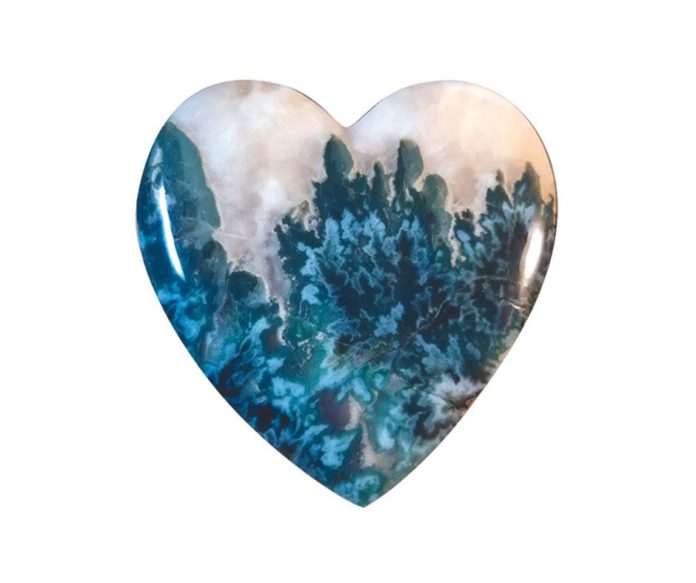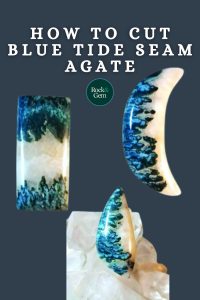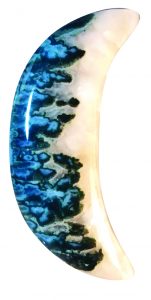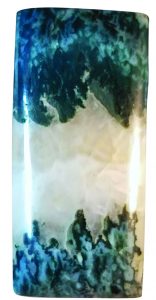
Blue Tide seam agate is one of the newest finds in Garut, West Java, Indonesia. The miners discovered it surrounding the pit where they were excavating some petrified wood. Though they call it agate, it’s still up for discussion about what this stone is. The white portion is soft calcite, but I’m not certain what the blue plume is — until it can be further tested.

This new material has certainly taken the lapidary world by storm in just a few months, and for good reason, it’s absolutely gorgeous! The various blue-colored plumes against a white canvas remind me of the famous Japanese painting “The Great Wave,” by Katsushika Hokusai. The material is often found in seams, with the blue plumes as the outer portion lined with white calcite.
However, some portions that are found can be very brecciated and have a nice fractal look, which creates different design options. One thing to note, much of this material is not very stable and tends to break rather easily, so cutting and cabbing this material can be a challenge.
Tips for Shopping for Blue Tide
 When shopping for this material, focus on the blue and white-colored material only. The grey areas are extremely soft and will almost definitely crumble off in the saw or during the cabbing process. The blue plumes have a decent hardness, much like cutting Noriega Crazy Lace, but the calcite areas are where precautions are needed.
When shopping for this material, focus on the blue and white-colored material only. The grey areas are extremely soft and will almost definitely crumble off in the saw or during the cabbing process. The blue plumes have a decent hardness, much like cutting Noriega Crazy Lace, but the calcite areas are where precautions are needed.
When starting to slab this blue tide seam agate, it’s rather easy to see where the blue bands are, so you know which direction to cut. However, if you want to experiment, you can crosscut this material and get completely different patterns, yielding primarily blue colors, but you will no longer get the plume patterns.
It’s best to hand-cut on a smaller 10-inch trim saw. If you use a larger saw it could tend to chew up and break apart the stone, plus the calcite areas will fill in with dirty cutting oil.
Trust the Stone to Pick Its Shape
Cabbing this blue tide seam agate can be a bit tricky, as it’s one of those  stones that will generally pick its cab shape more times than not, so always be ready to change shapes on the fly if portions break or chip off. Once you narrow it down to a solid area, I would recommend starting your cabbing on a 220-grit steel wheel and taking precautions and a gentle touch while shaping the cabs.
stones that will generally pick its cab shape more times than not, so always be ready to change shapes on the fly if portions break or chip off. Once you narrow it down to a solid area, I would recommend starting your cabbing on a 220-grit steel wheel and taking precautions and a gentle touch while shaping the cabs.
From this point, I like to use a 140-grit soft resin wheel to continue doming my cab and smoothing out all the scratches. The soft wheel at this stage usually aids in fewer breaks, by adding that extra cushion on the wheel while still shaping and doming nicely.
From here, continue with the usual progression on your cabbing machine to the 280-grit wheel, and again, using a gentle hand take your time smoothing the cab out and making sure there are no more scratches from this point on. Once you’ve finished on the 280-grit wheel, it would be a good time to stop and set the cab in a tub of water or leave it in the bay with the water flowing, allowing it ample time to cool off from the friction of the wheels.
If the stone generates too much friction, the calcite areas could loosen up and break apart. To finish your cab, continue your way through to either 8k or 14k-grit, and it should have a nice glossy finish. I wouldn’t suggest any further polishing with compounds since the compounds will fill in the calcite and dry in the cracks.
Blue Tide seam agate is available through David Maulana in Indonesia, either on his Facebook page or through his website at www.rockshoppind.com.
This story about blue tide seam agate previously appeared in Rock & Gem magazine. Click here to subscribe. Story by Russ Kaniuth.















